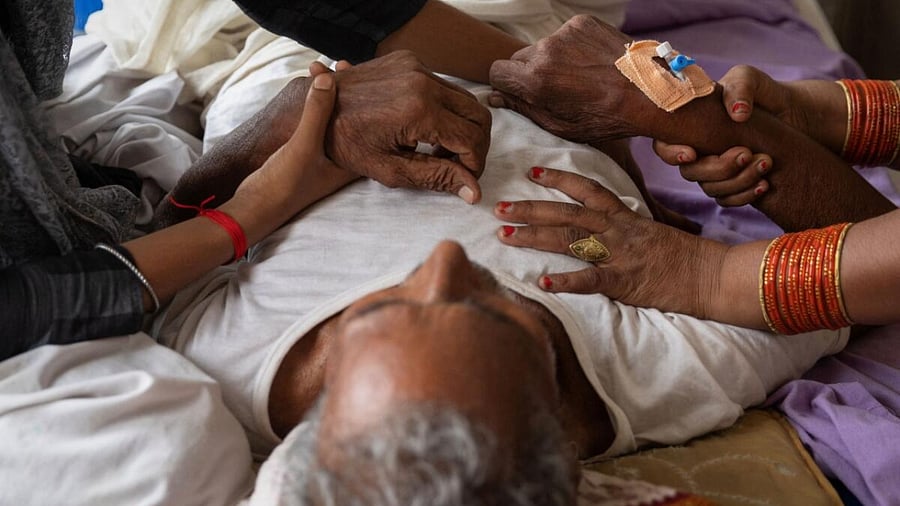
By David Fickling
With temperatures across India soaring above 45 degrees Celsius (113 Fahrenheit) this week, you'd hope the government had learned from last year's deadly heat waves and properly prepared the health system for the next climate-driven crisis. Temperature and humidity at levels now seen in South Asia’s pre-monsoon hot season are already testing the limits of human survivability. That risks mass deaths as the planet warms further this century.
Instead, attempts to even enumerate what is happening have become embroiled in bitter arguments. Nearly 100 people have died from heat-related conditions in two of the country’s most populous states in recent days, the Associated Press reported this week — but officials, including medics, have disputed the claims. The Indian Express newspaper reported that one hospital superintendent who’d publicly linked deaths to heatstroke was later removed from his position for giving “a careless statement.” It then quoted a doctor who’d visited the same clinic as saying the causes were unclear.
The episode is emblematic of the explosive potential of heat wave deaths in the divisive political atmosphere in the giant state of Uttar Pradesh that’s led by a firebrand from Prime Minister Narendra Modi’s BJP. Beyond that, though, it’s symptomatic of the parlous state of health services and public data in a country that lacks the means to even know for certain how many people its broiling climate is killing, let alone take measures to help them.
Going by some numbers, the effects of high temperatures on India’s population seem remarkably slight. Last year’s brutal heat wave season, which saw temperatures in Delhi as high as 49.2 Celsius, is widely quoted as resulting in only 90 deaths. The figure is an estimate based on media reporting cited in one of the first studies to measure the influence of climate change in the disaster. That study admits the two-digit number is likely an underestimate: In the city of Ahmedabad alone, a 2010 heat wave resulted in 1,344 heat-related deaths. So far, however, it’s the closest we’ve got to a figure.
The Covid-19 pandemic gives an insight into why better numbers are lacking. Most deaths have multiple causes. When one is a novel and politicized event such as an epidemic or heat wave, people may tend to either overplay or downplay this factor. When a 65-year-old with angina has a heart attack on a day when the temperature touched 45 Celsius, did they die of heat, or heart disease?
In Pics | Tips to stay cool during the hot weather
That can lead to distorted figures. China changed its standard for attributing coronavirus infection and pressured doctors to name other issues during its outbreak last year, in each case serving to suppress reported mortality.
A common solution to that problem is looking at excess deaths — comparing recorded fatalities with the number you’d expect in a typical year to iron out the effects of reporting bias. One excess-deaths study last year found that as many as 4.9 million people in India had died during the first 18 months of the Covid-19 pandemic, compared to the 412,000 officially recorded Covid deaths.
Even that approach may be inadequate in India, however, because the most basic data on mortality is too patchy. Nationwide, roughly 8 per cent of estimated deaths in 2019 went unrecorded, according to an annual government survey, and only 19 per cent of the total were certified by a medical professional, a step considered routine in most countries. In Bihar, a province neighboring Uttar Pradesh on the lower Ganges with a population bigger than Japan’s, just 52 per cent of deaths were recorded and 5.1 per cent were medically certified.
As a result, biases are baked into every level of information. For instance, though women and men die at roughly similar rates, women account for just 40 per cent of registered mortalities — not because of their longevity, but the fact that their low social status means their deaths are less likely to be recorded.
The people most at risk from heat waves are the poor, the old and very young, and those in isolated rural areas. These are precisely the groups who are most likely to be missed from official tallies of vital statistics. Measuring excess mortality, as a result, mostly gives us a picture of how extreme temperatures affect the urban middle class, rather than the population as a whole.
This information gap could be fatal. Without solid figures, it’s impossible to know which populations are most at risk, or where medical and emergency supplies should be sent when hot spells are forecast. India’s health care system may be threadbare in its cities, but in rural areas it can be close to non-existent. Mortality that isn’t measured doesn’t get addressed. On a planet that warms with each passing year, India’s data deficiencies are fueling a deadly complacency.